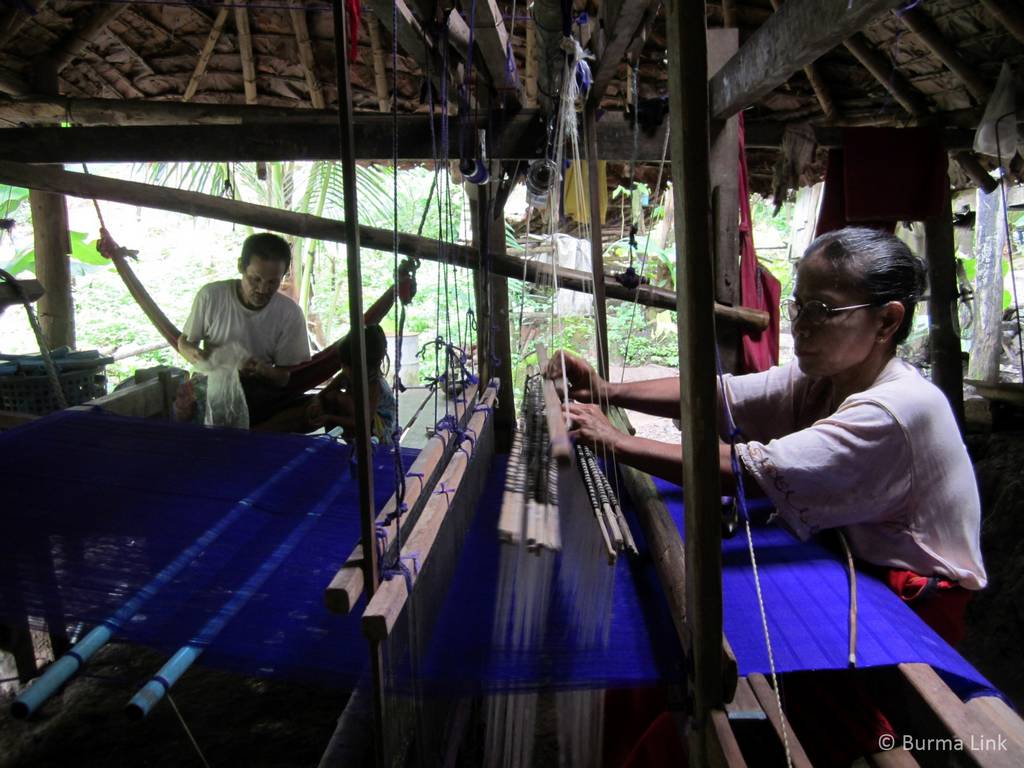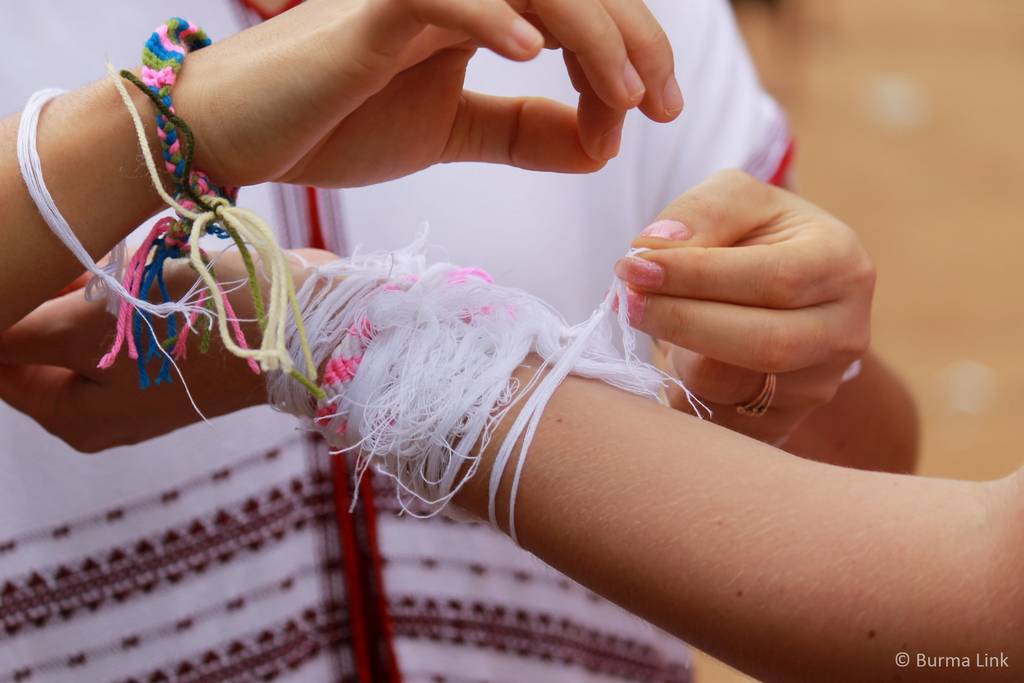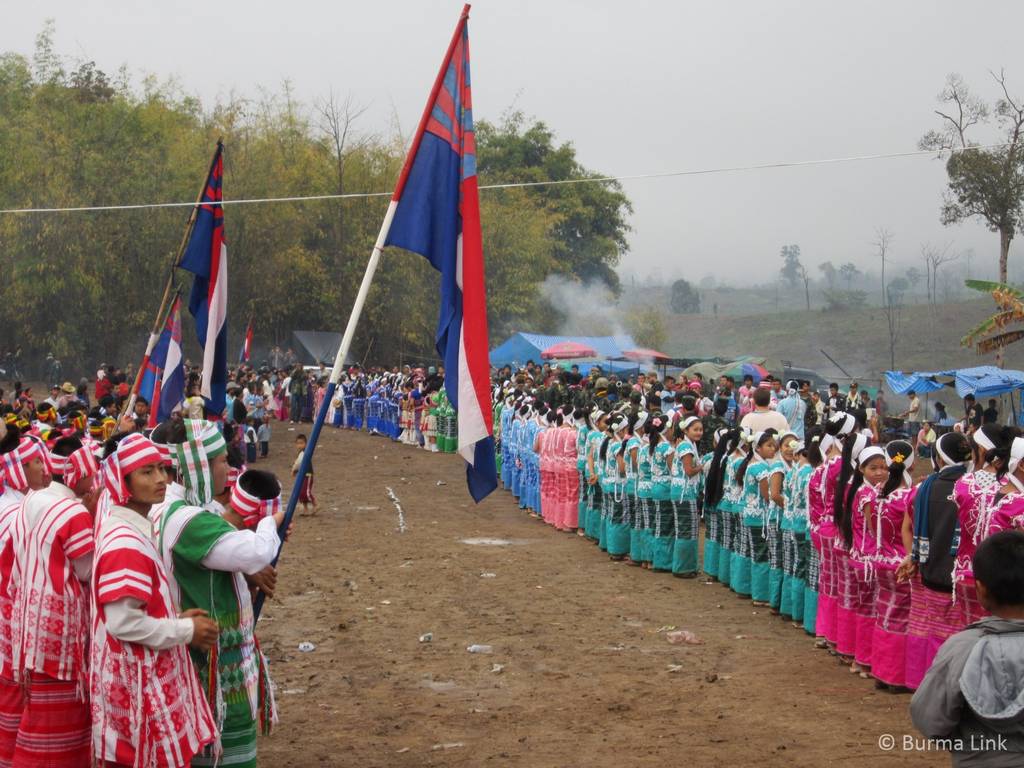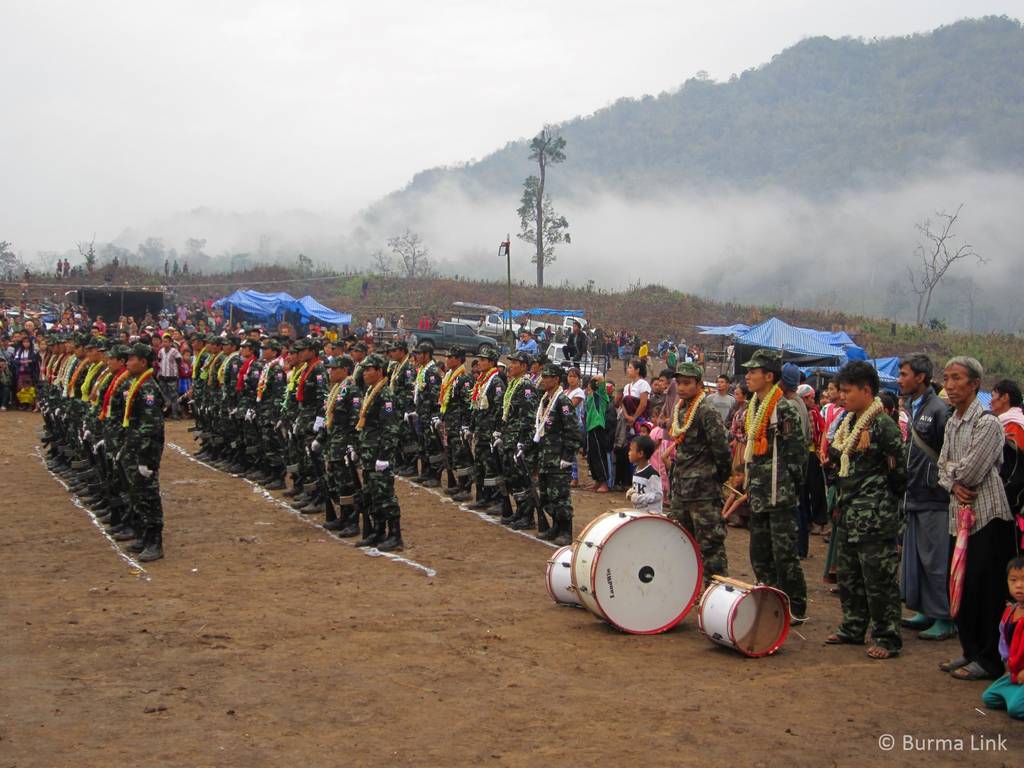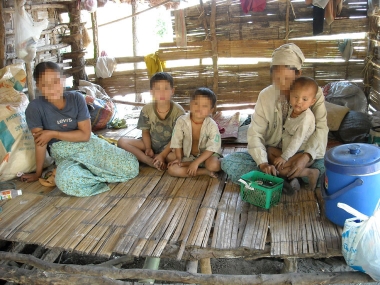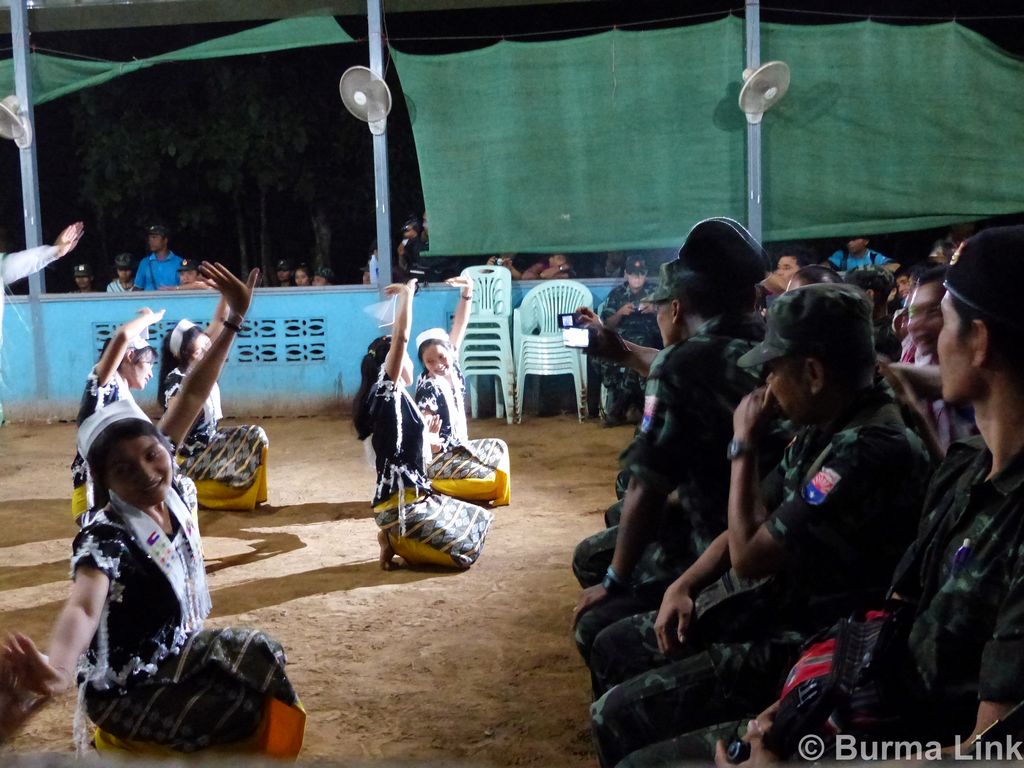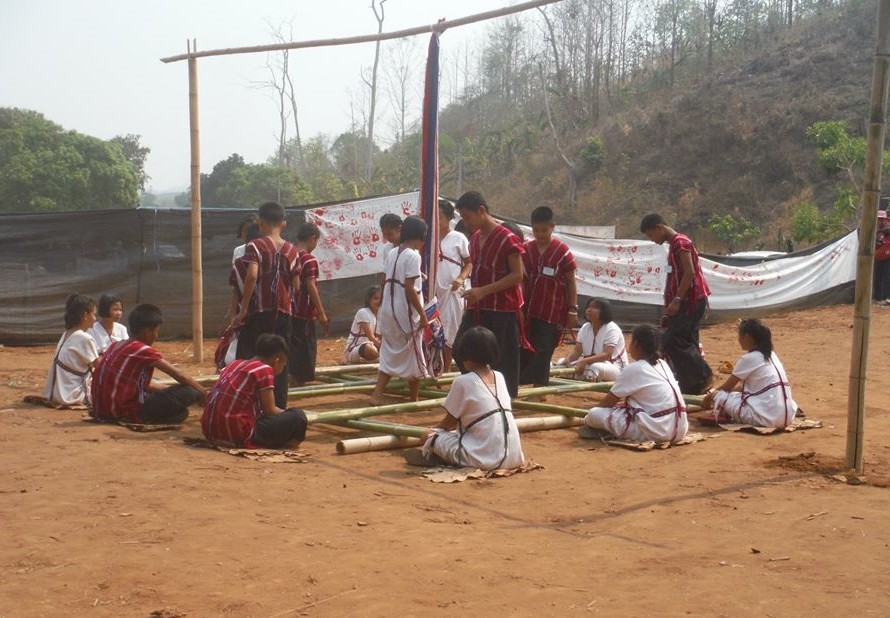According to the Karen National Union (KNU, see Karen National Union):
“The Karens are much more than a national minority. We are a nation with a population of 7 million, having all the essential qualities of a nation. We have our own history, our own language, our own culture, our own land of settlement and our own economic system of life”.
Although some Karen believe that they came to Burma before the Mon and the Burman around 3000 BC, there is no clear historical evidence that explains the time of Karen settlement. The Karen are thought to originate from Mongolia, and they now live throughout much of lower Burma, with the main populations in the Irrawaddy Delta and Thai borderlands. The Karen describe themselves as peaceful, obliging, and hardworking people who place high value on education.
The most important Karen celebrations are the Karen New Year, celebrated in December or January, the Karen State Day celebrated on November 7, and the wrist-tying ceremony, celebrated between July and September.
Although there are more than 20 Karen subgroups, over 70 % of Karen come from two main groups; the Sgaw who are predominantly Christian and mainly inhabit hill areas, and the Pwo who are predominantly Buddhist and mainly inhabit the lowlands. Karen dialects occupy the Tibeto-Burman branch of Sino-Tibetan languages. While the Karen people speak at least 12 dialects, the Karen language has three main branches; Sgaw, Pwo, and Pa’o (see Thein Lwin, 2011). The scripts have been developed from written Burmese.
When Christian missionaries arrived to Burma in the 19th century, many Karen were animist. The Karen had an ancient story of a white brother who would come and bring an important book of knowledge that would greatly improve their life situation. Consequently, many Karen warmly welcomed the missionaries believing that the prophecy had finally come true (see Rogers, 2004).
Christian missionaries introduced a script for the Karen language and built school and hospitals in Karen areas. The British rule over Burma was largely welcomed by the Karen as their living conditions improved during colonisation. The Karen even spoke of the British as ‘liberators’ from historical oppression by the Burman kings and many fought on the side of the British both in the Anglo-Burmese wars as well as in WWII. While there were tensions between the Burman and the Karen before the arrival of the British, these events resulted in marked ethnic polarisation between Karen and Burman communities which has continued to the present.
While large numbers of Karen converted to Christianity during the colonial times, the majority of Karen people are Buddhists or Buddhist-animist. There is also a small minority of Karen Muslims, and small numbers of animists who live mostly in remote areas. Despite this diversity, many Western observers view the Karen as a more-or-less exclusively Christian people (Rogers, 2004).
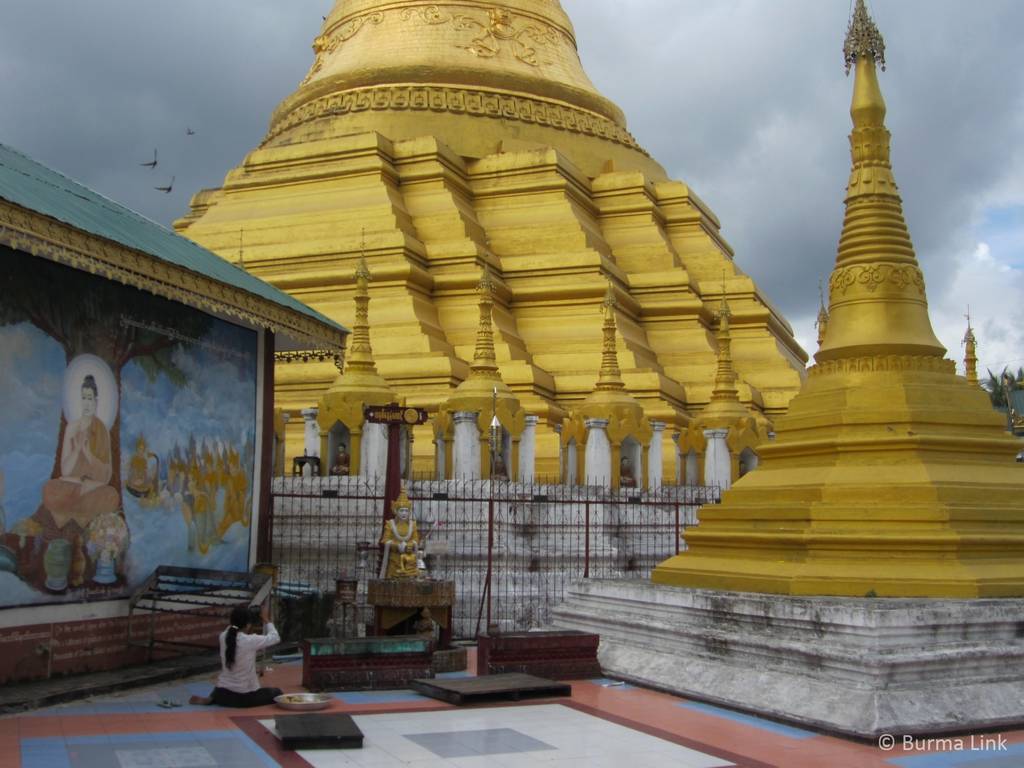
A Buddhist Karen woman praying in front of the golden Pagoda in Myawaddi, Karen State. (Photo: Ariana Zarleen)
Religious diversity is of particular significance for the Karen as Christian and Buddhist Karen have in the past engaged in armed conflict against each other. Many Christian Karen feel persecuted because of their religion, and many Karen believe that the Burmese government uses religion to disintegrate them and to drive a wedge between Christian and Buddhist Karen:
“…Buddhist and Christian groups get separated. They kill each other. It’s a very sad thing… As for religion, we should pray as we like. Buddhists should pray for Karen. Christians should pray for Karen. We join together because united we stand, divided we fall. Religion is our change opportunity. It is a good thing but it can turn into a dangerous thing. The Burmese can divide us by using religion. Religion can be used as a weapon. Religion can be used as a scapegoat”. (Older Karen monk, Centre for Peace and Conflict Studies, 2010, p. 65)
Despite the Karen’s close ties with the British, the early nationalist Karen movement was greatly handicapped by the manner in which the British had placed some Karen land in Ministerial Burma and some in the Frontier Areas. Following the formation of the KNU in February 1947, Karen leaders decided on boycott tactics and were absent from the Panglong Conference organised the same month. As a consequence, the wording of the clauses relating to Karen rights and territories were left undecided until after independence. After the assassination of General Aung San on July 19, 1947, representative talks with the KNU never took place.
Having failed to reach a political agreement with the newly independent Burmese government, KNU went underground on January 31, 1949, at the battle of Insein, celebrated as the ‘Revolution Day’ ever since. Many observers accused the KNU leadership of being overly ambitious in its territorial and political claims at the time, while others emphasised the strongly-held Karen aspirations for national self-determination as well as the deeply-set grievances felt by Karen communities as a result of abuses perpetrated by the Burmese army during WWII (see South, 2011).
In June 1949, KNU declared to the world the formation of the Karen Free State of Kawthoolei. A year later the KNU president and a Karen national hero, Saw Ba U Gyi, was killed in an ambush and Karen forces were gradually pushed back from lowland Burma into the eastern borderlands. Nevertheless, KNU and its armed wing Karen National Liberation Army (KNLA) continued to operate in villages close to Rangoon up to the early 1960s (for more information on the Karen struggle, see South, 2011).
When Ne Win took over power in the military coup in 1962, KNU saw its first internal split into pro-and anti-communists. This split was of importance as it left the door open for Ne Win’s ‘Four Cuts’ campaign. In Karen areas as well as elsewhere in eastern Burma, the Four Cuts strategy aimed to cut off the four main links – food, finance, intelligence and recruits – between civilians and armed opposition forces by a campaign of non-stop military harassment. Large areas were declared ‘free-fire’ zones, and entire communities were forced to move to fenced areas subjected to tight military control. Thousands of Karen communities were destroyed as a result of the policy.
Another related factor in understanding the situation of the Karen is the Burmese army’s use of civilians as a base of support; local military units have been required to follow a policy known as ‘living off the land’ in order to sustain themselves, which has led to widespread exploitation of the local civilian population for labour, food, money and other supplies (KHRG, 2011a).
After the 8888 uprising KNU’s position seemed strengthened as some 10,000 student democracy activists fled mainly to KNU controlled areas seeking refuge from the government forces. They established a series of camps, where the student soldiers received military training as well as supplies from the insurgents. The political significance of these new arrivals was considerable. All in all, between the late 1940s and early 1990s, the KNU was arguably the most significant of Burma’s ethnic opposition groups. For much of this period, the KNU operated as a de facto government, controlling large areas of territory across the Karen State and its adjacent areas.
In November 1988, KNU and 22 other anti-government groups formed the Democratic Alliance of Burma (DAB), a joint ethnic opposition front. As a result, the early 1990s witnessed the emergence of large DAB ‘liberated zones’ (see e.g. South, 2011).
Following the 1989 collapse of the Communist Party of Burma (CPB), the strength of armed opposition began to decline partly due to the ceasefires agreed by the regime with different ethnic opposition forces, and partly due to a lack of unity and political skills among the different opposition groups. Particularly heavy fighting ensued and by the 1990s, KNU had lost control of most of the once-extensive liberated zones. KNU still continued to exert varying degrees of influence over areas in Burma’s eastern borderlands. At the time, KNU also suffered from a dramatic fall in revenues that were derived from taxing the black market, cross-border trade, and logging deals.
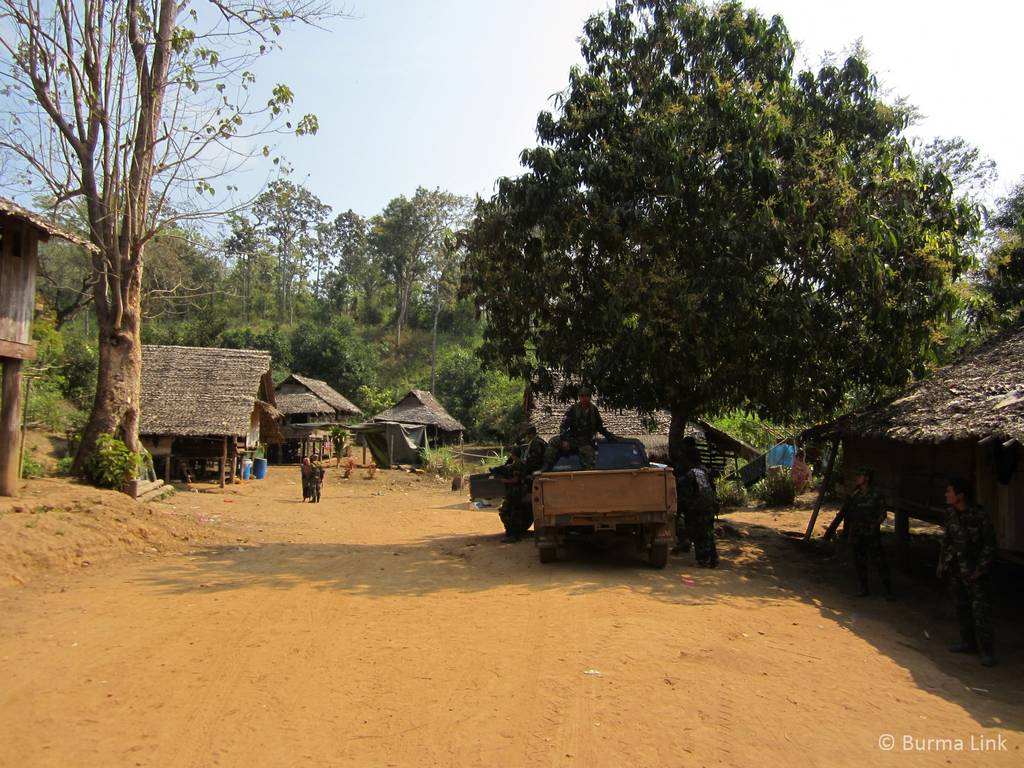
KNLA soldiers visiting a local village located in a liberated are inside the Karen State. The KNU built the village for displaced Karen in 2012. (Photo: Burma Link)
In 1995, KNU was forced to retrieve from its headquarters in Manerplaw, causing some 10,000 refugees to flee to Thailand. The same year, KNU also lost Kaw Moo Rah, its last major base north of the Thai border town of Mae Sot. These events were huge setbacks both to KNU as well as the pro-democracy movement on the Thailand-Burma border. Part of the reason for the Karen army defeat was that KNU had witnessed a split only one year before they lost their headquarters, when the Democratic Karen Buddhist Army (DKBA) had become a breakaway group of Buddhist soldiers and officers of KNLA.
While some have argued that the formation of DKBA was a product of poor political skills at the top of KNU combined with often deeply-held grievances among many Karen Buddhist community members (South, 2011), many Karen as well as other observers (e.g. Rogers, 2004) believe that the Burmese government masterminded the split and used religion as a scape goat to divide and weaken the Karen resistance. Shortly after their breakaway in 1994, DKBA signed a ceasefire with the Burmese army. Much of the DKBA largely functioned as a government proxy army and fought against the KNLA.
Within a few years of its 1994 formation, DKBA had overtaken KNU as the militarily and economically most powerful Karen non-state actor, largely due to the significant economic privileges it enjoyed as a government proxy army.
The 1990s led to a significant decline in KNU’s authority and to the reorientation of Karen armed groups. DKBA was only one among a number of armed militias made up of ethnic Karen, other breakaway groups including the Karen Peace Force (KPF, previously KNLA 16th Battalion), the Karen Peace Council (KPC), the Karen Border Guard Force as well as various other local militias. The Burmese military’s divide and rule polices were largely successful in weakening their most significant opposition.
In an infamous statement a Burmese army commander General Tin Ngwe told his officers:
“In three years if you want to see the Karen, you will only find them in a museum” (Smith, 1994, p. 45).
In 2003, KNU and SPDC agreed to suspend hostilities in accordance with the so-called ‘Gentlemen’s Agreement’, which according to witnesses led to even more IDPs inside the Karen State as the killings and rapes continued in many districts (Thanakha Team, 2005).
Fighting in the Karen State continued and intensified after the 2010 election. Under the pressure from the military government, between 2009 and 2010 many significant non-KNU armed Karen groups, including most battalions of DKBA, were transformed into Border Guard Forces (BGFs) under direct control of the Burmese army. The position of such groups remains highly problematic, as they not only act as proxies for Burmese military but have unclear political agendas, often focusing primarily on economic issues (see e.g. South, 2011).
It has been argued that for many observers, the history of the Karen armed nationalist movement is synonymous with that of the KNU (e.g. South, 2011). Likewise, for many Karen nationalists, KNU enjoys a special status as the vanguard of the revolution. Nevertheless, Karen civilians reportedly have a range of opinions regarding different conflict actors. According to South (2011), DKBA’s widespread use of coercion and arbitrary taxation and conscription tactics are widely resented by people living in the border areas, and many Karen (Christians but are also Buddhists and animists) express considerable sympathy for KNU as representing ‘our people’.
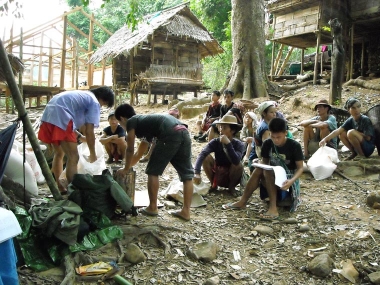
IDPs in Lu Thaw Township receiving emergency food support given by local KNU officers. (Photo: KHRG)
Peace talks between the KNU and the central government that started in late 2011 have made some progress, and according to a report by Physicians for Human Rights, fighting and assaults on civilians were less frequent in 2011 than in previous years (Davis, Gittleman, Sollom, Richards & Beyrer, 2012). While a historical preliminary ceasefire agreement was finally reached between KNU and the government’s government in January 2012, political dialogue is yet to begin.
In the process, KNU has also found itself amidst a heightened sense of crisis as a major internal division over how to proceed in peace talks has threatened to escalate. In 2012, some argued that the power struggle within the KNU leadership could even lead to another split in the party (Saw Yan Naing, October, 2012). Many observes blame the internal splits and disparities on the government’s attempt to divide and rule the Karens as well as other ethnic nationalities, also by offering financial and business incentives to Karen leaders in order to lure them away from their original goals.
KNU is holds regular elections and administers all the functions of government in areas under its control. These responsibilities are administered by 14 departments as well as the office of the General Secretary.
KNU provides local services in the Karen State such as those provided by the Karen Education Department (KED) and the Karen Department of Health and Welfare (KDHW), organises aid for the internally displaced Karen, and has also undertaken extensive efforts to rebuild villages destroyed by the Burma Army and the DKBA. The KNU aims to establish a genuine Federal Union in cooperation with all the Karen and all the ethnic peoples in the country for harmony, peace, stability and prosperity for all.
KNU uses Sgaw Karen language as an official language in its areas of control, where Sgaw Karen is taught and used as the medium of instruction at schools. Sgaw Karen is also used in the Karen refugee camps on the Thailand-Burma border. The Karen living outside the KNU controlled areas learn their native Karen languages at churches and monasteries. Thousands of Karen have learned about their culture as well as to read and write their own languages in refugee camps in Thailand.
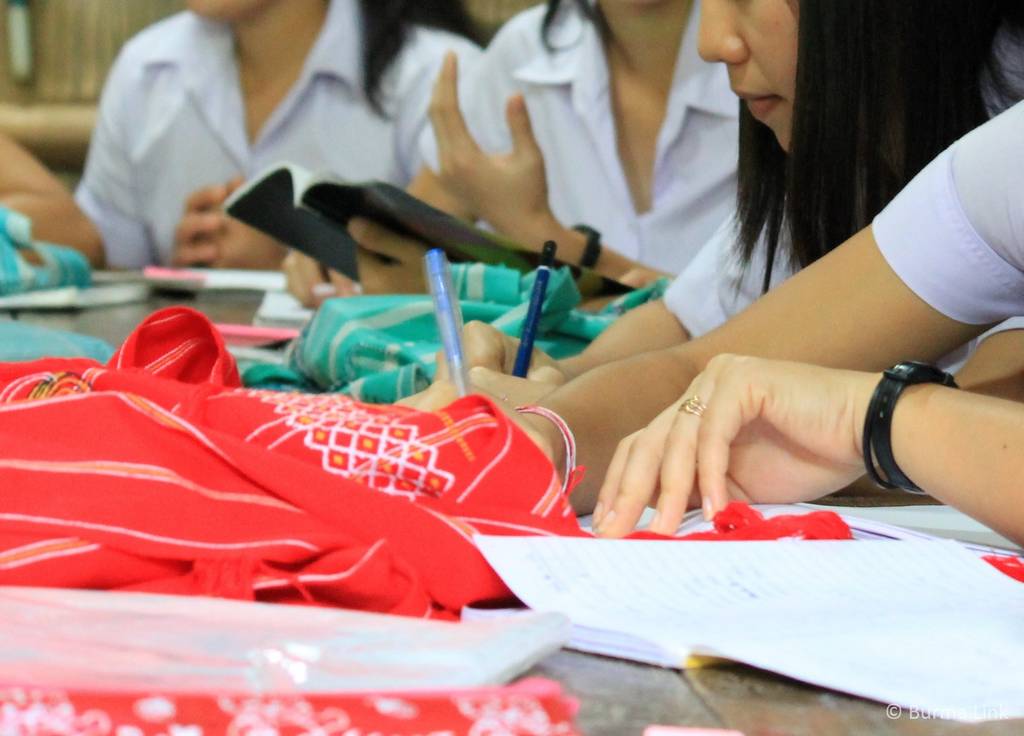
Thousands learn about their cultures as well as to read and write their own languages in refugee camps in Thailand. (Photo: Liz Bordo)
Many Karen-populated areas have been subject to insurgency and often brutal government counter-insurgency operations since 1949. Humanitarian impacts on civilian populations have been immense. Tens of thousands of Karen villagers have been forcibly relocated from their homes and scores have fled into Thailand. Of all Burma’s ethnic nationalities, the Karen are arguably among those who have seen the most severe reversal in their fortunes since independence.
The Karen have suffered of extrajudicial executions, forced labour, forced relocation and confiscation of land, human minesweeping and the burning of villages, rape and other forms of sexual violence, as well as open discrimination by state authorities (see e.g. Centre for Peace and Conflict Studies, 2010; Davis, Gittleman, Sollom, Richards, & Beyrer, 2012; KWO, 2004).
Some (e.g. South, 2011) have noted that Karen non-state armed groups have also perpetrated a range of abuses, including forcible taxation and unlawful killings. As South (2008a) points out, however, KNLA soldiers seem to be involved in human rights violations on a far less systematic level than either the Burmese army or the DKBA. The vast majority of abuses have been committed by the Burmese military and its proxy armies. Human rights abuses reportedly continue in the state (e.g. Davis et al., 2012; KHRG, 2012b: ND-Burma, 2013b).
Only about 25% of the Karen population live within the borders of the present Karen State, while the majority live scattered through Rangoon, Irrawaddy and Tenasserim Regions, eastern Bago Region and the Mon State (South, 2011). While most of these communities identify themselves as Karen, for the majority of them the struggle for day-to-day survival is the main priority, and issues of political affiliation are often secondary considerations.
Many Karen areas where armed opposition and the government’s counter-strategies have come to an end, communities are still vulnerable to a range of threats, including various forms of violence and deep-seated poverty. Fear of the Burma Army and human rights violations also remain high.
Despite KNU’s prominent status, after over six decades of conflict, KNU/KNLA is only one of several Karen armed groups that are still active. Nevertheless, KNU’s long struggle against the Burmese military government has given it significant symbolic weight and prestige that stretches beyond its actual military and political achievements.
The long and troublesome history with the majority Burman and the Burmese (mainly Burman) military government has resulted in deeply-felt prejudice amongst many Karen. According to a survey research conducted in Burma in 2009, the Karen perceive other inter-ethnic relations to be relatively peaceful whilst many cite negative relationships with the Burman (Centre for Peace and Conflict Studies, 2010). Anti-Burman attitudes are often being passed on from parents to their children, and the Karen often generalise their experiences with the military government to apply to all Burman people:
“Karen normally hate Burman. They are enemies. The government is killing us so much, so people hate this government”. (Middle-aged Karen businessman, Centre for Peace and Conflict Studies, 2010, p. 257)
The ongoing violence in the Karen State has also led to structural changes in the life of rural Karen communities. As the Burmese army began extending their influence over the lowland rural areas of eastern Burma and the persecution of male village chiefs became more intense, men became unwilling to risk their lives in this position and women were increasingly asked to be chiefs (see KWO, 2010). It seems that today women chiefs have become commonplace in these lowland rural Karen areas. As clearly demonstrated by KWO report (2010), this practice has not resulted in less persecution or abuse by the Burmese military directed towards the village chiefs (see also the story of a Karen village chief).
Significant concerns also remain over human rights abuses associated with economic development projects that the Burmese are promoting in ceasefire talks and also about protecting the health of the Karen people (Davis et al., 2012). These concerns are particularly relevant today as international donor money is increasingly shifting away from CBOs that have traditionally been key players in delivering health care to vulnerable populations on both sides of the Thailand-Burma border.
In 2014, tensions have begun rising again between the Karen and the Burmese, with many clashes reported in September between the DKBA and the BGF (see e.g. Saw Yan Naing, September, 2014). Karen armed groups have shown increasing willingness for military cooperation, as shown by the formation of Kawthoolei Armed Forces (KAF) in October 2014, which reunifies the forces of KNLA, KNDO, DKBA and KNU/KNLA-PC under one umbrella (KAF, October, 2014).
More than 90,000 people remain internally displaced in the Karen State (TBC, 2013c) and more than 90,000 Karen refugees reside in official refugee camps in Thailand (78% of the registered refugees, TBC, August, 2014). Many more live as undocumented migrants outside the camps. Due to lack of opportunity and proximity to Thailand, many Karen people also migrate to Thailand to escape poverty and lack of opportunity.
The dreams of many Karen people are simple and those taken for granted by many people in other parts of the world:
“I am not sure what will happen for the long term. But what I want is PEACE. I want things to get better. I want to have a simple good life. Because of the war, porters and summer work, I cannot have a proper life. If there is peace I think I will have a good life. That is what I want and all the villagers want that as well”. (Karen woman village chief, KWO, 2010, p. 25)

